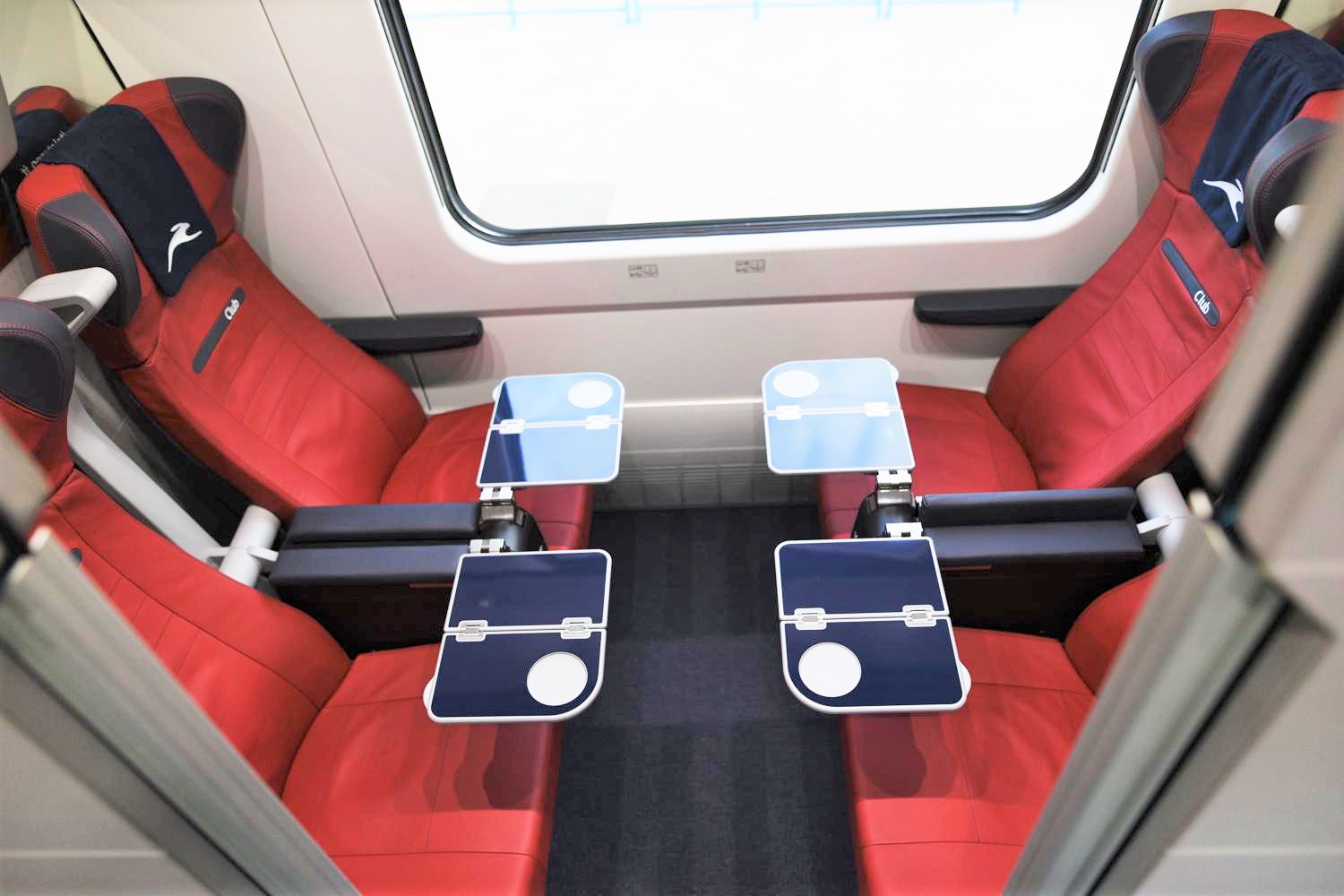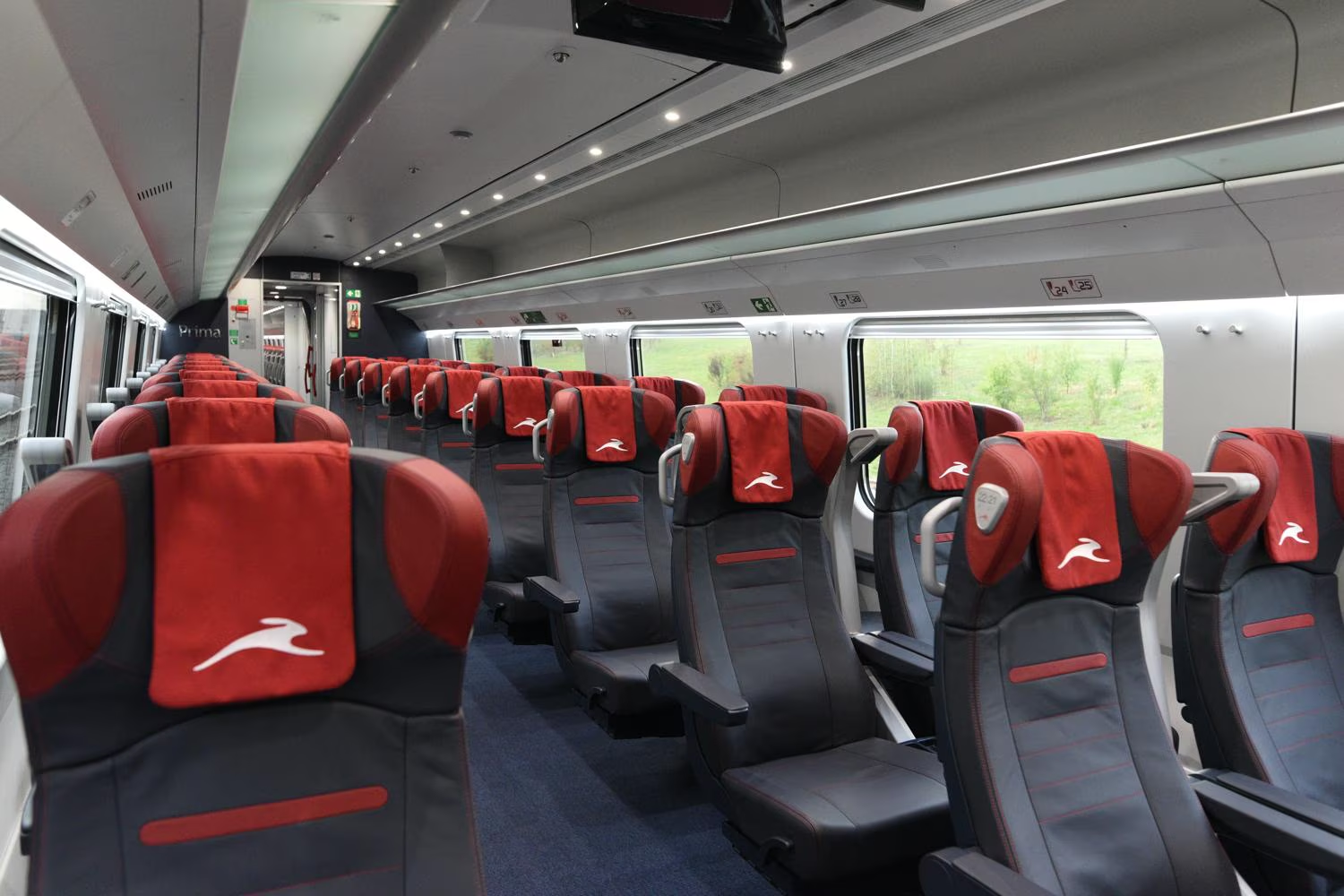Rolling stock • Block train • High speed train • Italy • NTV-Italo • Pendolino Alstom ETR 675
Note: For educational purpose only. This page is meant purely as a documentation tool and has no legal effect. It is not a substitute for the official page of the operating company, manufacturer or official institutions. It cannot be used for staff training, which is the responsibility of approved institutions and companies.
Read the full package on NTV-Italo:
The company → AGV Alstom ETR 575 → Pendolino ETR 675 → Train services → Economics
In brief
ETR 675 EVO
With the business outlook for 2014-2015 difficult and complicated, rather than cut back, management decided to invest in new rolling stock.
Rather than a high-speed train like the ETR 575, NTV has opted for the Pendolino, an Alstom technology, for a train that will run between Turin and Venice, where stops are more frequent. The ETR 675, manufactured by Alstom, does not feature the tilting mechanism traditionally associated with Pendolino trains, as its primary operation on Italy’s high-speed lines renders such technology unnecessary .
blog.tuttotreno.it
NTV initially ordered 12 ETR 675 trainsets in 2015, with subsequent orders bringing the total fleet to 26 units by 2021 . The first trains entered service in December 2017, enhancing NTV’s service offerings by increasing daily operations and expanding to new destinations .
Each ETR 675 trainset comprises seven cars, measuring 187.3 meters in length and accommodating up to 476 passengers . The interior is divided into three classes: Club, Prima, and Smart. Technically, the ETR 675 is designed for a maximum speed of 250 km/h and operates under both 25 kV AC and 3 kV DC power systems . It features a distributed power system with asynchronous three-phase motors and is equipped with both ERTMS and SCMT signaling systems, ensuring compliance with European safety standards.
Family name: Pendolino
Class: ETR 675 (Italy)
Manufacturer(s): Alstom
Train type: Trainsets
Sector: Passengers transport
Type of service: Main line
Operator(s): NTV-Italo (26)
First services: 7 December 2017
————————
Train length: 187.3m
Maximum speed: 250 km/h
Traction system: Asynchronous three-phase motor 6FJA 3257
Electric system(s): 25 kV 50 Hz AC, 3,000 V DC
Pantograph: 4
Braking system(s): Dynamic and Regenerative brake
Track gauge: 1,435 mm
————————
Formation: 7 cars – Three classes
Seats Club Executive: 19
Seats Prima: 123 (+2 for disables)
Seats Smart: 332
Restaurant car: no
Bar car: no
Total seats: 476
The introduction of the ETR 675 has allowed NTV to optimize its fleet by deploying these trains on routes where the higher speed of the AGV 575 is not required, thereby expanding service coverage and improving operational efficiency.
The definition of a high-speed train varies by region, but generally, it refers to trains that operate at speeds of at least 250 km/h (155 mph) on newly built lines and 200 km/h (124 mph) on upgraded lines. In Europe, for example, the UIC (International Union of Railways) considers a commercial speed of 250 km/h as the principal criterion for high-speed rail. In the United States, the definition can include trains operating at speeds ranging from 180 km/h (110 mph) to 240 km/h (150 mph).
➤ See the UIC definition
In addition, the european’s TSI gives two high-speed classes (according 2008/232/EC point 4.2.1.1 b) :
• Class 1: trains with a maximum speed of 250 km/h or more;
• Class 2: trains with a maximal speed of at least 190 km/h, but less than 250 km/h.
Background and development
The EVO is part of the Avelia family, Alstom’s range of high and very high speed trains. Alstom built his Avelia portfolio to enable to find the best solution for each operator. Alstom’s Avelia™ high-speed train range covers maximum operating speeds between 200 km/h and 350 km/h. Models can be either single-deck or double deck, and with or without tilting technology.
Pendolino is the name of the train built by the old firm Fiat Ferroviaria since the 70’s, which Alstom bought in April 2002. This train is not entirely a “high-speed” train, although it can reach 250km/h, just at the limit of high speed. It has been designed to take curves more quickly, and is used in the Czech Republic and Poland. However, the version purchased by NTV-Italo differs from its eastern brothers in that it has no tilting system, which is not necessary on a route such as Turin-Milan-Verona-Venice.
The Pendolino is now part of Alstom’s Avelia Stream range. While we have seen some of the differences between the EVO and the ETR.600/610, there are many more points in common between the two types. Both are made up of seven elements and can travel in pairs to offer 14 cars.
Although the structure is derived from that of the ETR.600/610, the new design of the ETR.675’s front end necessitated the repetition of aerodynamic and noise measurements (interior and exterior) carried out with the application of pressure sensors and high-speed travel. The removal of the driver’s cabin doors has made it possible to gain space, which translates into an increase of 8 seats in the Smart (in car 7).
Each electric trainset consists of two segments that can – but only for shunting and maintenance purposes – move on their own: one consists of carriages 1 to 4, the other of the remaining three: carriages 4 and 5 are those on which the pantographs are mounted – so one is needed for each half-train.
The motorised carriages are 1, 2, and 7 and offer a total power output of around 5,600 kW under both voltages, capable of travelling the convoy, which has a total mass of almost 400 tonnes, at 250 km/h regardless of the type of power supply. The three central carriages are towed. All the pantographs are single-arm Schunks: two for 25 kV 50 Hz alternating current, the other two for 3 kV direct current.
It is easy to recognise the imprint of the ETR.600 in these features! As proof of the close relationship, the overall length of the ETR.675 is 187.3 m, compared to 187.4 m for the ETR.600. Carriages 4 and 5, the only ones equipped with pantographs, are also the only ones to have access doors from the outside at both ends, while on the ETR.600/610 only carriage 3 is equipped with a single door on each side (on carriages 1 and 7, one door on each side is reserved for the train crew, while as mentioned, direct access to the cabin is not present on the ETR.675).
It is distinguished also by a redesigned nose, different from its Eastern European sisters, as shown in the drawing below:

But what has changed about the nose? The European Commission provides Decisions or Regulations in the railway sector that are called “Technical Specifications for Interoperability” (TSI) and published in the Official Journal of the European Union.
With the TSI 2014, the crash standards have changed. For example, the windscreen can no longer be attached to the aerodynamic fibreglass shell, but must be anchored to the metal structure forming part of the body. On the other hand, the TSI 2014 no longer requires the presence of boxed structures at the vestibules of the carriages, nor are the doors for drivers to enter the cabin from the vestibules used by passengers compulsory. These variations led to the new front (and more) of the ETR.675. The “beak” does not disappear completely, but becomes much less pronounced.
Production of the bogies took place at Alstom’s Le Creusot plant, while the carriages were built at the Savigliano plant in Italy. Delivery of the 26 ETR 675 EVO trains to NTV was completed in 2021, thus completing the planned supply.

On-board comfort: NTV-Italo’s choices
This 187.3-metre-long, 7-car train can accommodate 476 passengers and reach a maximum speed of 250 km/h, putting it just inside the ‘high-speed’ range. Contrary to the ETR.600/610, which are equipped with a bar area in carriage 3, NTV has chosen to prioritise the number of seats available, divided among NTV’s 3 classes or ‘ambiances’:
Like the ETR 575, NTV-Italo’s Pendolinos only offer three ambiances:
• Club: 19 seats (including 2 lounges of 4 places);
• Prima: 123 seats plus 2 seats for persons with reduced mobility in carriage 3;
• Smart: 332 seats in Smart.

On the ETR.600 there are instead 432 seats (126 in Prima and 306 in Second), and on the ETR.610, 430 seats. So, by the removal of the bar, NTV increases the number of seats for about 10%. Catering is indeed entrusted to 4 vending machines. The ‘Smart Cinema’ ambience, however, is no longer present on the EVO ETR 675, as this equipment is to be used on routes in northern Italy with frequent stops, which means greater comings and goings.
Car 1 – Ambiance « Club »

The interior of the EVO trains is a different colour scheme: ruby red predominates, as in the external livery. The EVO seats are supplied in Pulterirrima leather, with blue and red details on the headrests. Each seat has a USB port, to ensure that passengers can connect their devices to the on-board portal and charge them during the journey. The personal Club Executive screens no longer appear on EVO trains.

The “Club” area has a total of 19 seats. 4 seats are located directly behind the driver’s seat. This is followed by two salottinos, each seating 4, opposite a bar-café. The suite ends in another small room with a further 9 seats. Apart from the absence of individual screens, the service and benefits of the “Club” ambiance remain identical.



Cars 1 and 2 – ‘Prima’ ambience
EVO Prima seats are also supplied with Pulterirrima leather armchairs, mostly blue with red detailing on the headrests. Most of the seats are placed in individual aircraft-style positions, half in one direction, half in the other.


Cars 3, 4, 5, 6 and 7 – ‘Smart’ ambience
The seats in the Smart ambience, still in leather, are grey with red details on the headrests. Each seat has a USB port so that passengers can connect their devices and charge them during the journey.

Launch
NtV-Italo launched the first four sets on December 7 2017, just before the start of the winter timetable three days later. With the start of the new timetable on December 10, NTV was able to increase the number of daily services on its network from 56 to 68. Train frequency was stepped up again in 2018 to 90 trains per day when delivery of the Evo fleet was completed.
The arrival of the new ETR.675s has enabled a reorganisation of NTV’s train services and an optimisation of the use of the “older” AGV 575s.
The former, due to their maximum speed of 250 km/h, was used on the Naples-Rome-Verona-Brescia/Padua-Venice route and also on the Naples-Rome to Bolzano route (extension of two pairs currently based in Verona), as well as on a new Turin-Milan-Venice connection.
The AGV 575s, on the other hand, were be concentrated on the Salerno – Milan – Turin route, where they were be able to express their speed qualities to the full with a peak speed of 300 km/h, strengthening Italo’s offer on what is the busiest route in Italy, with a train every 30′ at peak times.
In addtion at this time, 160 new staff were be recruited as on-board and ground personnel to cover the needs dictated by the new services. These included 45 train drivers to cover new services. 🟧

NTV-Italo /4 – Train services →
[TOP]
Main line • High speed Rail • Italy • Lexical
